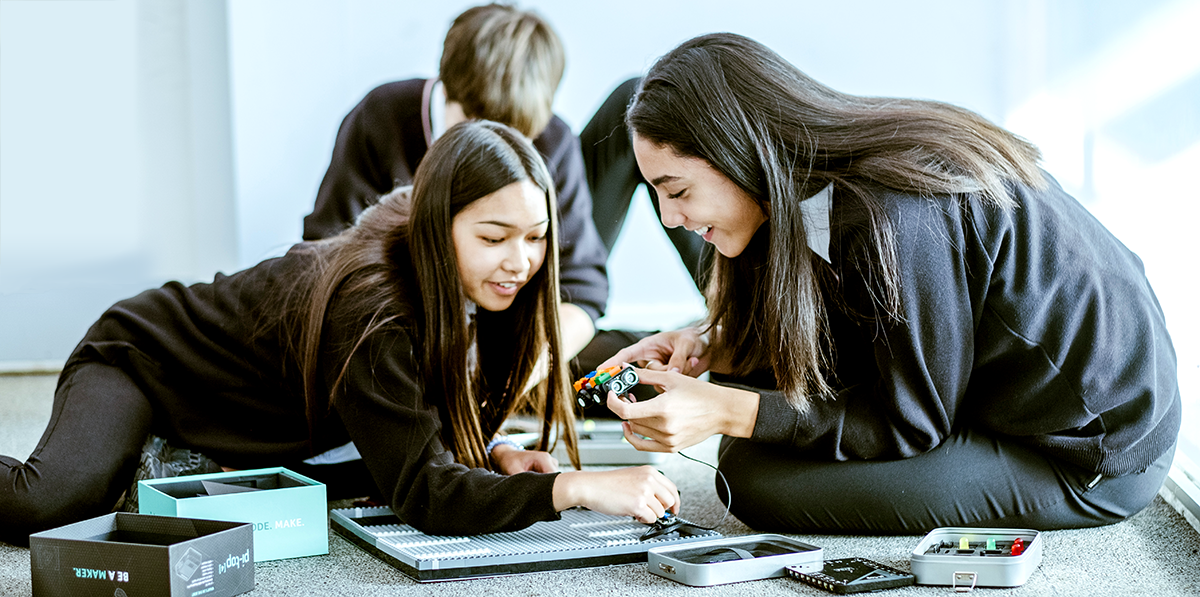
ON THIS PAGE.
Across the world, we see more and more schools and educators adopting some form of project-based learning or PBL. Educators are well aware of the power that creative, critical thinking can do for their students.
However, the successful implementation of PBL isn't always easy. There can be a lack of resources at a school to effectively put PBL into practice or to truly understand best practices around how to create truly meaningful experiences that open a student’s mind to thinking critically and becoming creative problem solvers.
So, let’s weed out the ‘extra’ words and jargon and get straight to the heart of what PBL is, the research behind it, what are some best practices around implementing PBL, and how PBL plays nicely with STEM (without negating the fact that PBL works beautifully in any subject area). This short and to the point overview will hone in a tried and true pedagogical method we know works – and can be a game-changer in our classrooms and STEM activities.
I hear and I forget. I see and I remember. I do and I understand.
Confucius.
Regardless of grade level, students are exposed to real-world problems and challenges that affect them both directly and indirectly, all the time.
And students today are very well informed about various situations and current news topics. Whether from hearing the news at home, learning about current events in class, or from experiencing situations first-hand. For example, a third-grader may be exposed to a real-world issue of seeing a classmate (or more than one) who doesn’t get enough to eat (i.e. food insecurity). More recently, in the news, we see an extensive movement of students of all ages taking a stance and leading the charge towards tackling the problem of climate change.
Across the board, some of the most common overarching ‘themes’ our students of all grade levels face are:
The point is, real-world problems affect our students on a daily basis. As teachers, we know this. We see this. We feel this in our classrooms.
And our students are not immune either.
How many times have we heard our students mention they wish they could change an outcome to specific circumstances? When our students start to wonder ‘what if,’ they have arrived at the right moment to start exploring. Their ‘what if’ question becomes the driving question to the start of a project-based learning opportunity.
Project-based learning challenges students to think outside the box to actively seek answers to questions they have.
Project-based learning (PBL) is a teaching method that brings learning to life, ignites student creativity and curiosity, and allows students to explore connections between school to the world around them.
And tackling real-world problems in collaborative, critical, and creative ways is the foundation of project-based learning.
As we discuss what PBL is (and is not) and before we take a deeper dive and explore best practices of this game-changing teaching strategy, it’s worth discussing one of the most common misconceptions around projects and project-based learning.
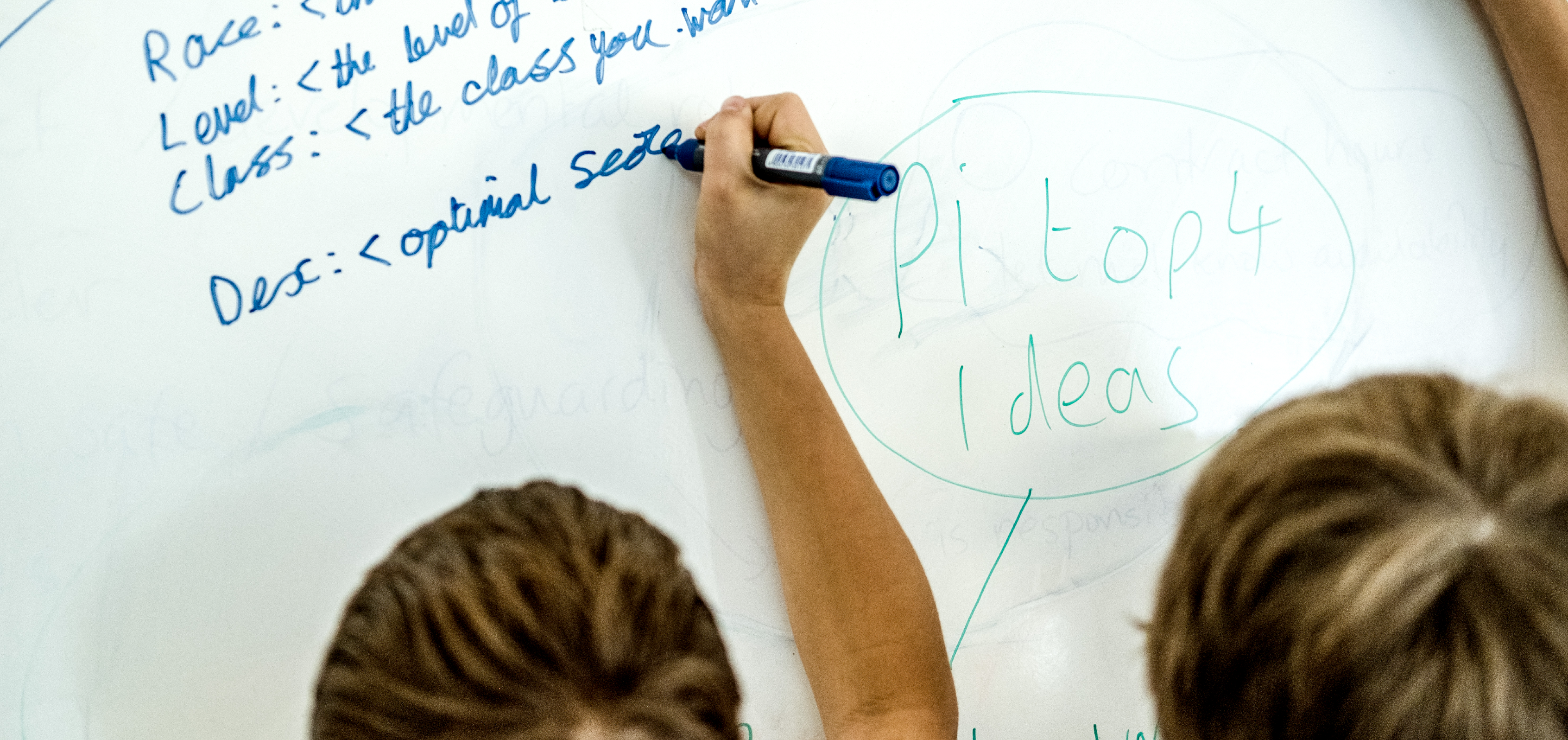
What is the difference between a project and project-based learning?
While projects are a fun way for students to demonstrate knowledge and understanding of concepts and standards, they are a single, one-off assignment. So, project-based learning is not to be confused with students completing “siloed” projects.
The best analogy to describe the difference is that a single project can be thought of as a lesson, and PBL can be thought of as the unit. In PBL, students learn through projects, not completing a culminating project for a grade.
In project-based learning, students learn about the world in which they live by “actively engaging in real-world and personally meaningful projects” over a period of time.
Two great overview videos on project-based learning to get you started are:
The simple answer is ... everyone.
Project-based learning works for all students as it develops critical thinking and problem-solving skills. It also leverages collaboration, communication, soft skills, and reflection.
Think about your classroom for a moment. Think about the different students in your room and all the diverse abilities and personal characteristics. Based on what we’ve talked about what PBL is, can you think of anyone PBL wouldn’t work for? Even in the toughest classrooms and schools, PBL works!
Just ask Dr. Nadia Lopez. As the founder, she opened Mott Hall Bridges Academy (a STEM-focused school) in 2010 in the Brownsville neighborhood of Brooklyn, New York.
Nadia's neighborhood had extremely high rates of poverty and crime, but she was determined to help children overcome the challenges of her neighborhood through PBL. She did this by teaching her students a foundational principle: “I’m going to teach you the fundamentals of what it means to be a creator, not just a consumer.”
Did you know that soft-skills can be thought of as 21st-century skills?
When we talk about "future-proofing" our students, we don’t just mean their tech-savviness (although that is a huge component), or through their attainment of hard skills (or knowledge of subject areas). We also mean supporting our students in soft skill development!
As our students prepare for college and career and life beyond our classroom walls, strong soft skills are highly sought after by employers. According to Collabera, research from the National Soft Skills Association reports that 85% of job success comes from having well-developed soft skills. And 16% of employers believe soft skills are more important than hard skills when screening job candidates.
The World Economic Forum lists the top growing skills for 2020 to include characteristics such as analytic thinking, active learning, creativity, technology design and programming, critical thinking skills, and complex problem-solving.
While tech and programming is more of a ‘hard’ skill our students would clearly benefit from learning, it’s clear that soft skills are currently, and will continue to grow, in demand by employers.
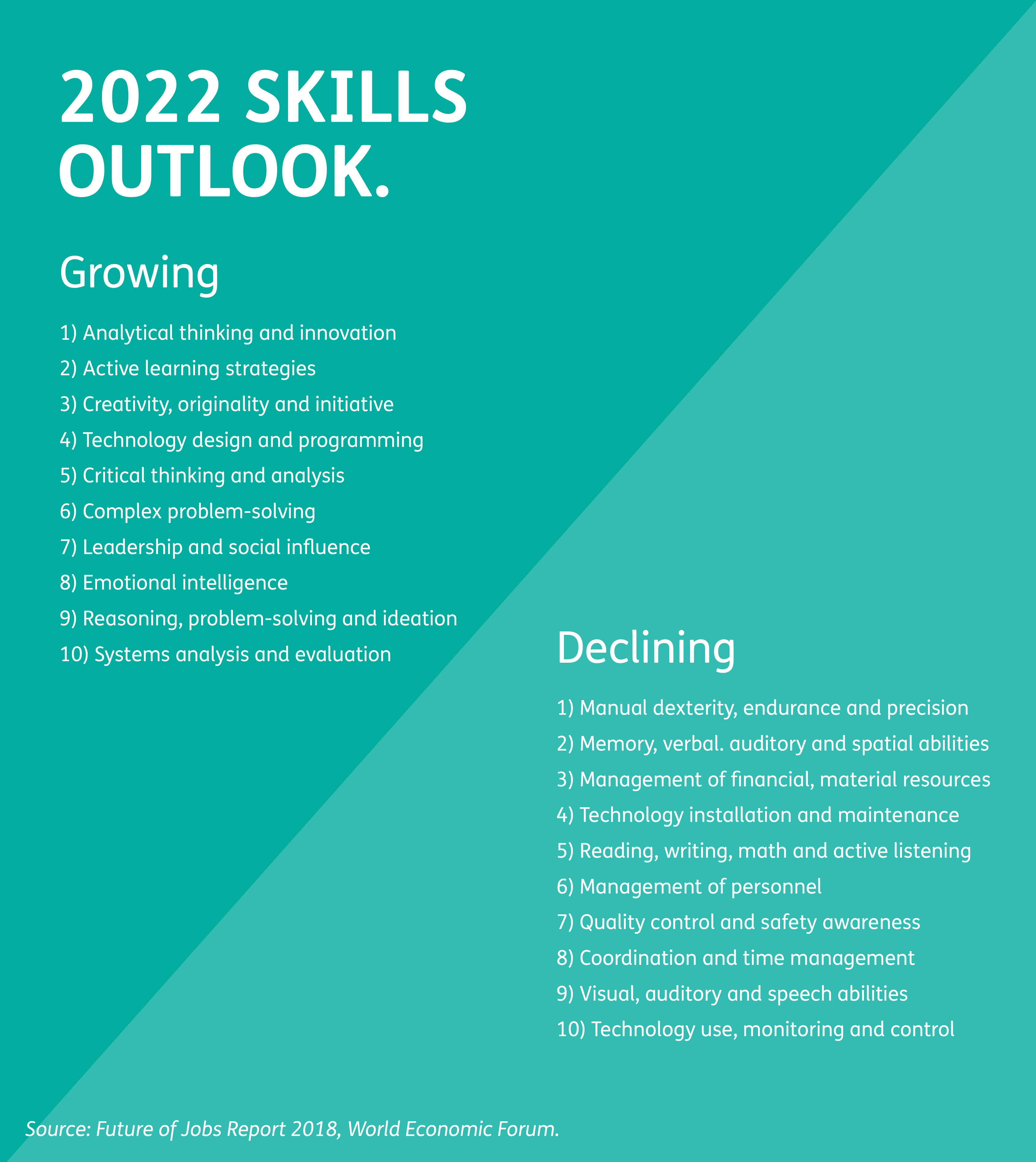
Project-based learning naturally leads to the development and sustaining of key soft skills students need today and tomorrow. And, to name a few, some of those sought after skills include:
The fact that PBL supports all our students, encourages a deeper understanding of content, allows for meaningful connections between school and the real-world, and aides our students in the soft skills they need for future employment, it’s a wonder why we don’t employ this instructional strategy more often in our schools – and libraries!
Additionally, as we start to understand what project-based learning is – and is not – we can’t help but wonder how we got to this instructional strategy in the first place. Where did it come from? And more importantly, how do we know it actually works? After all, educators always have to show research and proof of effectiveness when deploying new strategies and curriculum.
So how do we know that establishing PBL classrooms works?
Give the pupils something to do, not something to learn; and the doing is of such a nature as to demand thinking; learning naturally results.
John Dewey.
Think back to when you were in college in your core teaching preparatory classes.
You were probably introduced to several highly influential educational theorists and psychologists that established many of the instructional models and learning theories and strategies we use in our classrooms daily. As educators, we were introduced to – and are familiar with – the three major theories to learning: Behaviorism, Cognitivism, and Constructivism.
There was a reason we spent countless hours studying these different theories and how they contributed to shaping the way we teach, and how different curriculum is even developed. While these theories and strategies are what shape our education system today, we continuously build upon these ideas to meet the changing needs of learners.
Classroom teaching has dramatically evolved over the years, going from primarily teacher-directed instruction to student-centered instruction.
What is important to understand about project-based learning is that this is not a teaching fad, but well-rooted in research. The Buck Institute for Education has research that has demonstrated the impact on student learning in classrooms using PBL.
Project-based learning takes a student-centered approach, and in fact, the concept of "learning by doing" was first introduced by John Dewey in the 1900s! PBL is not a new idea necessarily. It’s just that it’s evolving in the way it looks in our classrooms.
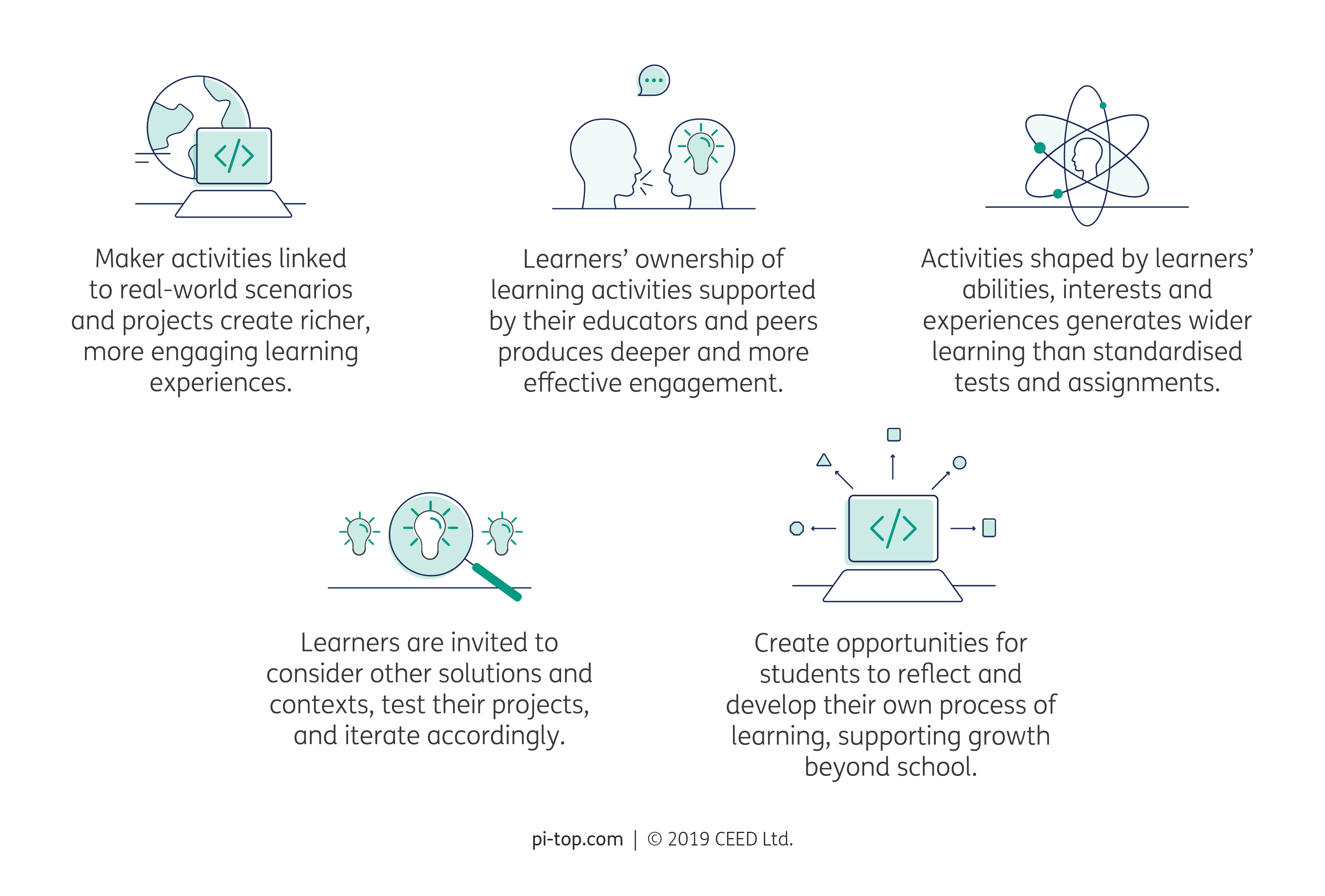
And the pi-top framework can also work into the Gold Standard: Project-Based Learning Practices by PBLWorks.org that identifies seven teaching practices:
Dr. William Rankin Ph.D., former Director of Learning & Research at pi-top, examines shaping a new generation of learning, with a humorous and non-technical approach, his short presentation explores ways to reimagine teaching and learning to offer a new way to chart the path for education.
Now that we’ve explored the foundation of what project-based learning is and the research that drives the support for PBL, let’s start to explore the natural fit of project-based learning in STEM and STEAM.
Teaching means creating situations where structure can be discovered.
Jean Piaget.
It was in the early 2000s when we really started to see and hear a push for STEM/STEAM within the education-verse in order to best prepare our students for a technology-rich future. When we started to look at the landscape of predicting future jobs, many landed within the STEM field. So what is STEM and STEAM, and what is driving us to develop highly engaging and extensive programs within our schools?
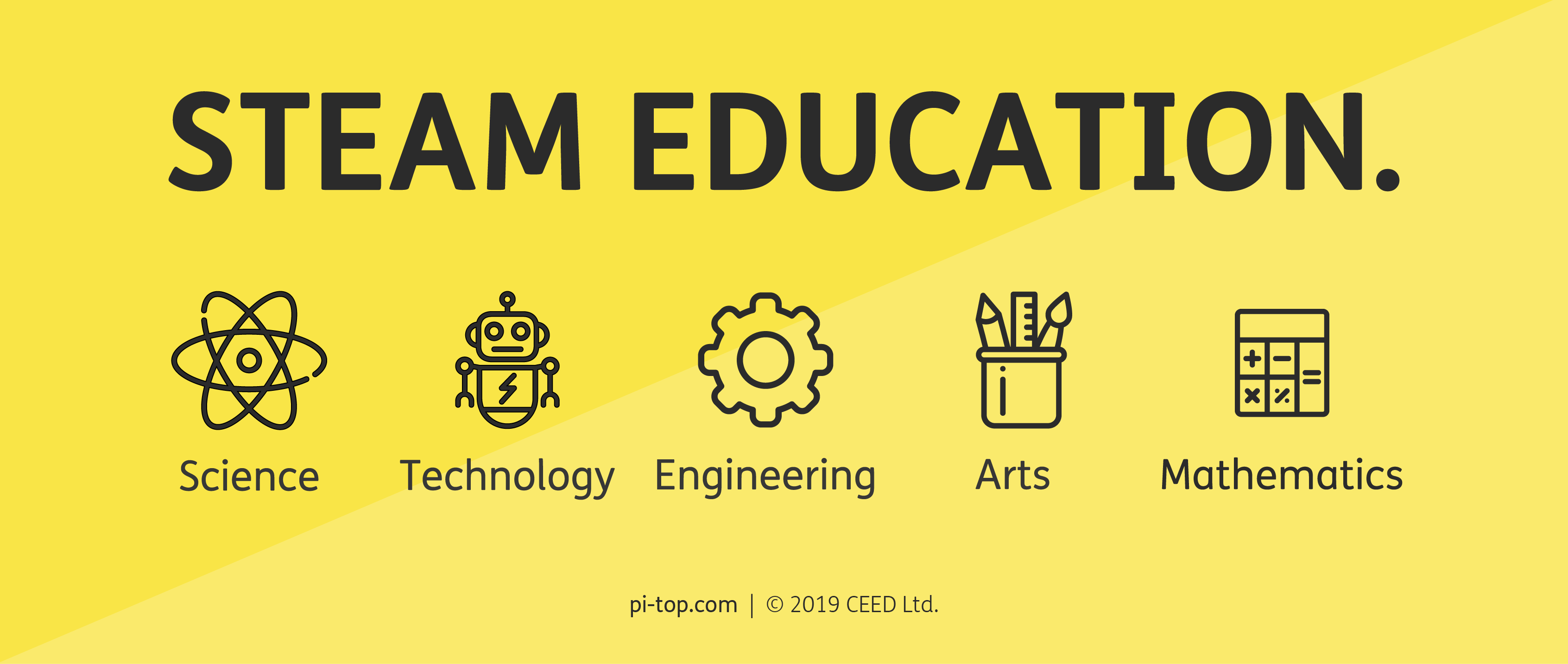
Across K-12 classrooms, college campuses, museums, makerspaces, after- and before school programs, businesses, and even in senior citizen programs, STEAM is making an enormous impact on how we view, teach, learn, interact, and think about the world around us.
Science + Technology + Engineering + Art + Math = STEAM
While you could argue that STEAM could be a ‘class’ (in theory, both informally and formally), STEAM is really more of an interdisciplinary program of study – or a contextual curriculum – that interweaves multiple subjects into an opportunity to teach students how science, technology, engineering, art, and math can, and do, relate and provide coordinated support to each other.
According to STEAMEDU.org, “STEAM ties ALL the subjects to each other in an interdisciplinary way as well as to the full spectrum of the rapidly changing business and professional world. It is a life-long career and life-readiness way of educating and learning that is adaptable to the rapidly changing global world we live in.”
With that being said, it’s no wonder then that the job market has positive outlooks for careers rooted in STEM.
The U.S. Bureau of Labor Statistics projects that nearly all STEM jobs are projected to grow faster than the average for all occupations. This is highly crucial information as we prepare our students to explore careers, college, and the workforce post-high school. For example, careers such as cybersecurity are growing at a rapid pace. In fact, Wyedean School in Gloucestershire, England, became a spoke school within the NCSC Cyber Schools Hub project. The Cyber Schools Hub (CSH) is a project that fosters collaboration between local schools, the National Cyber Security Centre (NCSC), companies and organizations who share the aim of encouraging young people to engage with computer science and cyber security principles.
It’s also no surprise then that so many schools are looking to place a higher emphasis on evaluating and implementing current and future STEAM programs within their districts.
There is no age limit to when we immerse ourselves in learning more about the world around us. And there is no set age as to when we start providing STEAM programs to children – or, for that matter, an age limit as to when they shouldn’t be available to adults.
STEAM programs benefit all.
STEAM programs:
When viewing just a few of the many benefits of a STEAM program, it's obvious that the benefits of project-based learning are strikingly similar. Again, another reason as to why PBL and STEAM make wonderful complementary partners in our instructional strategies.
When we teach our students the scientific method, we are already asking our students to think about the ‘what ifs’ of the world around them.
When we think about real-world issues, we know these are the things that students face (or will face) daily. These can be challenges, situations, products, and people. And these can be situations that can impact them and their community – whether directly or indirectly. Project-based learning allows students to explore and develop opportunities to change or overcome barriers that affect their ‘real-world’. We ask our students to think critically, problem-solve, and explore solving the driving question.
There are also two more key components to keep in mind when it comes to STEM and how PBL supports these teaching strategies. STEAM programs are adaptable and flexible to the needs of state and local programs focused on core curriculum and 21st-Century skills. Additionally, with this flexibility comes the ability to align to Common Core State Standards (CCSS), Next Generation Science Standards (NGSS), and other state standards. It allows for cross-curricular alignment and support for preparing students for multidisciplinary assessments.
Another point to note here is that these NGSS standards are internationally benchmarked!
Knowing that PBL places a heavy emphasis on process, making connections to the real-world, working collaboratively, leveraging technology, and communicating out results inherently draws a dotted line to the scientific inquiry, using technology, applying math, integrating reading and writing, and applying the engineering design model.
What does this mean then? STEM and PBL are a true compliment to one another!
Early on in elementary school, we teach our students about the scientific method. In fact, not only does the scientific method become a mantra (so-to-speak), but it becomes the root of our inquiry-based classrooms.
When it comes to a comprehensive STEM / STEAM program, we integrate science, technology, engineering, arts, and mathematics into the fold.
But have you ever wondered how both the scientific method and engineering design process come together for our students? You wouldn’t be alone if you did. While there are a lot of similarities, there are some differences that set the two apart.
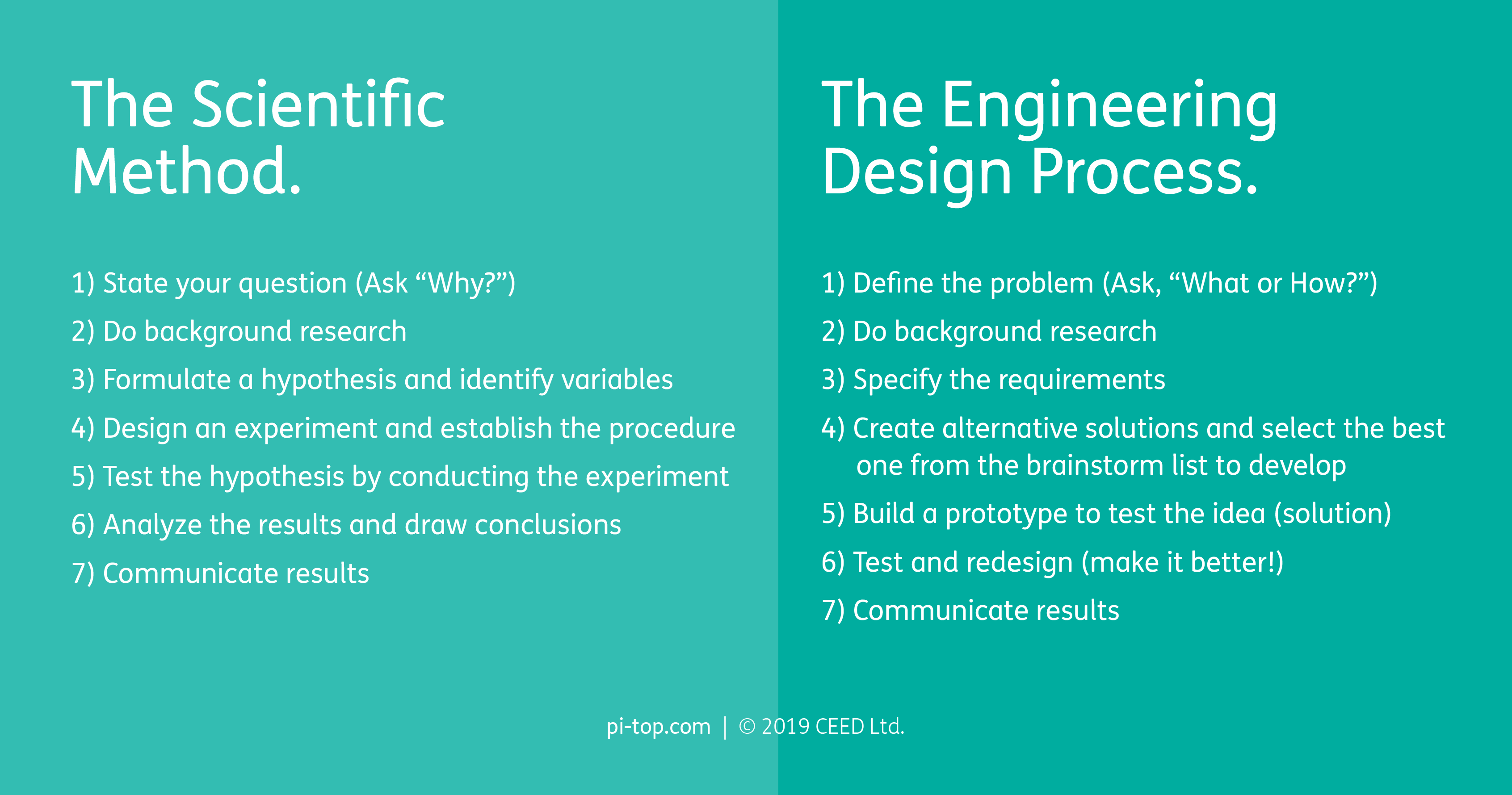
As you look at the table above, it’s easy to see how both are similar yet have clear differentiators that set them apart. And as you think about your classroom, I’m sure you are able to see how each can play a key role in STEAM.
Since all educators who teach science are well aware of the scientific method and how to teach it, let’s take a moment to really explore the engineering design a little more in-depth, as it plays a role in a STEAM PBL unit.
There are multiple visuals out there that depict the Engineering Design Process as a series of a different number of steps. The varying number of steps really depends on how granular you want to get. If you are an elementary teacher, you may want to start with a more simplistic five-step process: Ask, Imagine, Plan, Create, and Approve. If you are a middle school or high school teacher, you might want your students to dig a little deeper with the process. It’s also worth pointing out that engineers don’t always do all the steps in order. For example, an engineer may test a design only to find that the solution they thought would work did not go as plan. So back to the drawing board they go in order to redesign and retest to find the solution.
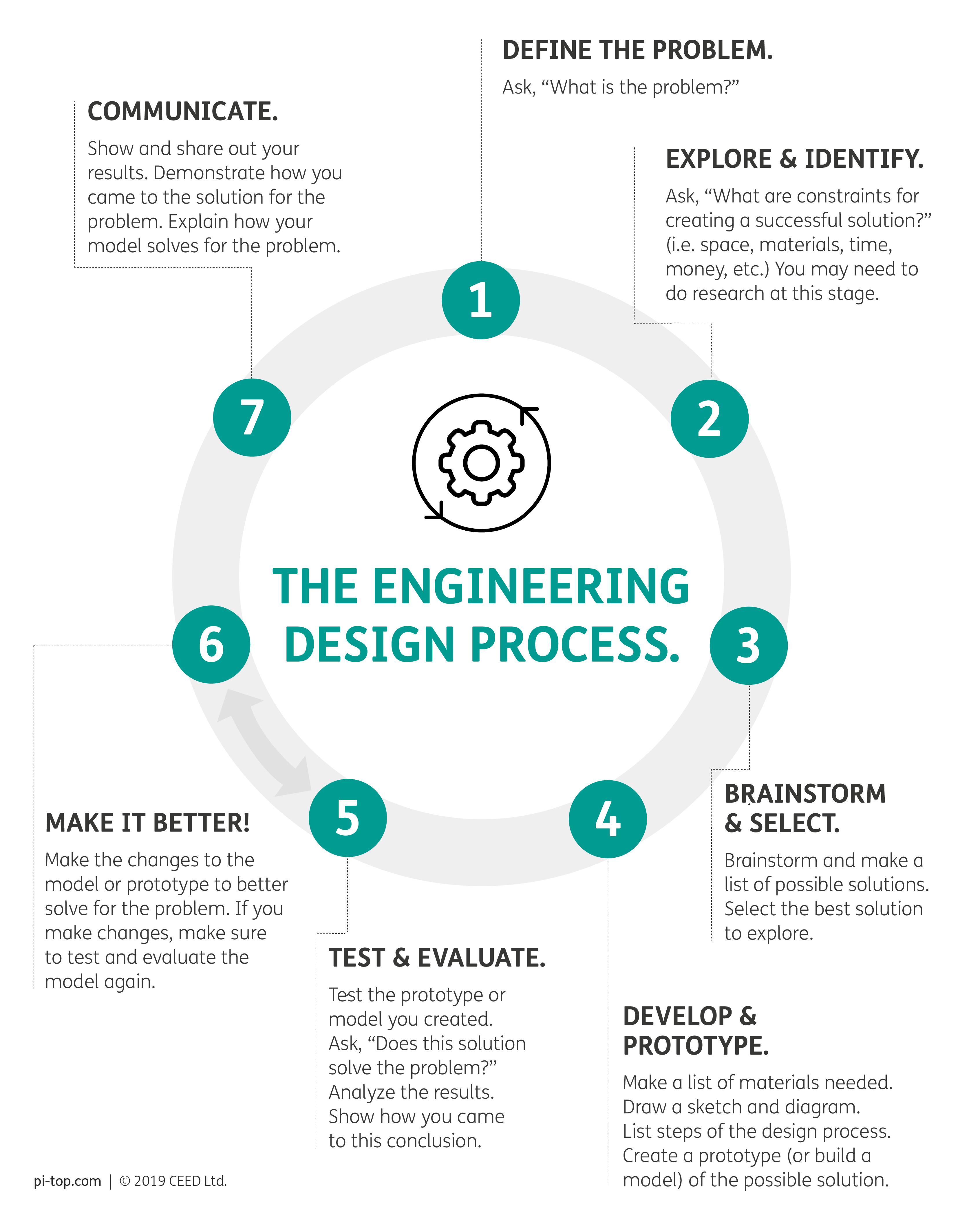
While project-based learning can be used in any instructional class, be it core, elective, or career and technical education, it almost feels like a natural fit for a STEM or STEAM class. And the more we explore and understand PBL, it really does become apparent how well PBL and STEAM strategies complement each other and research demonstrates this.
Education is not an affair of 'telling', and being told, but an active and constructive process.
Jean Piaget.
As you research and explore information on project-based learning, you’ll start to uncover common barriers as to why we don’t see more project-based learning in our schools. A couple of common barriers include:
Nonetheless, schools and classroom teachers are giving it a go with success!
Whether you’re at the beginning stages of developing a PBL STEAM program or have one currently in place, periodically evaluating your program helps to identify strengths, challenges, and areas you may want to change or expand on as the next steps.
Both inquiry-based learning and project-based learning are based on the instructional philosophies of John Dewey and rooted in constructivism, as discussed above. In fact, in the research of “STEM Project-Based Learning: Specialized Form of Inquiry-Based Learning,” describes how “inquiry-based learning go hand-in-hand in terms of student-centered instruction.” This guided us towards posing questions that might help schools and classrooms in evaluating their current programs and give food for thought on where they may want to move their STEAM programs towards next.
In your district, you may find the need to expand on these initial questions, as each state and local district has unique needs and requirements. Additionally, you may find terminology or phrases above that may be different than what is being used or depicted in your current programs. One of the most common aspects that are often overlooked is that of the integration of the Engineering Design Process, which is most commonly found in middle and high school settings.
Time is one of the most valuable resources we have in education.
It takes time to locate resources and plan, plan, plan for awesome lessons that really engage our students and best prepare them for life beyond school. And strategizing for new implementation models and integrating new curriculum and solutions can be a hefty undertaking too.
As we’ve previously mentioned, introducing project-based learning into your classrooms is not something that magically and perfectly happens overnight. But if you’re looking to kick-start PBL in your STEAM programs, where do you even start with planning out units?
When you ‘Google’ STEAM PBL resources, you will get an enormous amount of options to start digging through. Not to mention, there are a lot of ‘spins’ and opinions on the subject. You’ll also find a growing base of research as STEAM programs grow in depth and breadth, as well as PBL strategies taking hold in districts across the nation. The point is that getting started can be a little daunting. Below are nine steps based on a combination of findings and thought leadership from PBLworks.org.
If you are a teacher, curriculum director, or administrator who requires teachers to use the Backward Design instructional design model for developing lessons, then you can easily have a solid starting point in planning for your PBL units.
As you read through the above steps, did you start to see commonalities of how you already plan out your lessons? If you did, then you can start to imagine how overlaying Backward Design and PBL planning strategies may work.
‘Stage 1’ can include:
‘Stage 2’ can include:
‘Stage 3’ can include:
With the growing interest and popularity of developing project-based classrooms, comes a growing number of resources that teachers can tap into to get up-and-running right away or take the ideas and modify them for themselves. Six resources you may find beneficial in your next steps of learning and implementing PBL are:
Children learn best when they are actively engaged in constructing something that has a personal meaning to them - be it a poem, a robot, a sandcastle or a computer program.
Seymour Papert.
As we discussed at the beginning of this overview, soft skills are a key component to 21st-century skills, technology is the aspect that we often think of when it comes to preparing our students for the future of tomorrow. So it’s no surprise that tech is a 21st-century skill and aspect of a successful PBL strategy.
In project-based learning, the type of technology can take essentially take any form. And, to be honest, with the development of new technology and opportunities for schools to get access to different forms of technology, it’s nearly impossible to list them all. But, for the most part, schools leverage technology in the form of:
And many of the forms of technology listed above may be best suited for communicating out ideas. But does this form of technology really solve for technology in project-based learning? Chris Regini, a science teacher at West Hollow Middle School in the Half Hollow Hills School District in Melville, New York, challenged what it meant to leverage technology in PBL.
As demonstrated in the video, technology can be in the form of ‘inclusive’ devices such as pi-top. pi-top is a mobile computing platform that leverages the Raspberry Pi.
Leveraging technology to learn 21st-century skills, core subject concepts, as well as simply preparing students for jobs of tomorrow can be life-changing for students – including getting more girls involved in coding! Imagine what we can do for our students by giving them the opportunity to learn how to code, think critically, problem-solve, and work collaboratively.
Many schools leverage various funding to acquire the resources they need to support their project-based learning initiatives. Federal ESSA funding supports opportunities to acquire resources, and state and local funding opportunities can often be leveraged to ease access to technology and build 21st-century programs in schools.
|
We would be remiss if we didn’t tell our teachers about some of the great free resources you have available to you when you use pi-top devices in your classroom. In addition to the library of projects available in pi-top’s FURTHER platform, below are some external resources you might find helpful to get up-and-running using pi-top. And, just as a reminder, teachers, you don’t need to have a computer science degree to use pi-top in your rooms! Seriously. Get in touch with us and will explain how easy it is to get started with your students! Raspberry Pi Project Resources for Teachers:
|
Education, for most people, means trying to lead the child to resemble the typical adult of his society ... But for me, education means making creators ... You have to make inventors, innovators, not conformists.
Jean Piaget.
If you read through our 16 questions to evaluate your current STEAM PBL program, then you probably saw the last one that asked: “Does the STEAM program and classroom provide a makerspace, or a place devoted to student making?”
Makerspaces isn’t a term often used … yet.
So, have you heard of makerspaces?
If you haven’t yet, I’m sure you’ll start to see this term pop-up more often moving forward. Makerspaces can be found in libraries, schools, and various locations around cities throughout the world. Makerspaces can also be found in our classrooms. While makerspaces can take on a variety of definitions depending on who you ask, essentially, they are collaborative spaces that allow people of all ages - not just student aged - to explore, tinker, collaborate, and learn within high-tech, low-tech, and no-tech activities.
The ‘maker movement,’ like project- and problem-based learning, is another example of a learner-centric, active-learning methodology. As another form of constructionism, ‘maker’ education is based on learners developing an idea and then designing and creating an external representation of that idea. And, as with other constructionist approaches, it is learner-driven, with learner agency at its philosophical core. However, perhaps more than any other constructionist framework, maker education emphasizes “constructing knowledge through the act of making.”
Maker education works to prepare learners for the real world by giving them opportunities to approach, consider, and address real-world challenges of their own choosing, making whatever solutions or projects they feel are appropriate to do so.
A commonly described benefit of maker spaces is that they are not bound to a specific time or location. So, in addition to classrooms setting up maker spaces, they can also be established in a variety of settings and schedules outside of the core classroom. Maker spaces can be found in:
And makerspaces work!
Dan Ryder, teacher at Mt. Blue High School (and also a pi-top champion!), has three examples of student work that show how makerspaces transform student learning and achievement. Read his amazing story (straight from him) and how they started The Success & Innovation Center!
As you start to develop or expand upon your STEAM project-based program, creating a makerspace will ensure students have a place that is dedicated to exploring and thinking about the world around them.
STEAM PBL programs:
Despite all our wonderful intentions, sometimes, we, as teachers, make mistakes when implementing project-based learning and learning by making. First and foremost, it’s okay – and forgive yourself. Like we talked about earlier, project-based learning is not something you can easily implement with perfection, or even success, overnight. After you’ve forgiven yourself, reflect on what went wrong, when it went wrong, and revise! Just like we do when we’ve created a lesson that didn’t exactly go as planned. Another pro-tip is to learn from other teachers who have ‘been there, done that’ and have a t-shirt or two to back it up.
We’ve outlined five common mistakes to avoid when building a maker space in your school.
Throughout this reading, we’ve talked about the research, purpose, and goals of project-based learning, social constructivism, and learning by making. Social Constructionism is designed to give learners the sorts of critical thinking, creative, collaborative, and communication skills vital to thriving today and tomorrow. If you’re looking to jump-start your maker space, or take it to the next level, pi-top has you covered!

pi-top is committed to providing high-quality, engaging technology that is designed to inspire students to think ‘what if’ – and to start thinking critically about the world around them and challenges they can solve for. And the best part … teachers don’t need to have a computer programming background to get started! Leverage our library of projects to inspire a generation of makers to become the future problem solvers!
If you'd like to find out more about pi-top, fill in your details below and one of our team in your region will get right back to you.